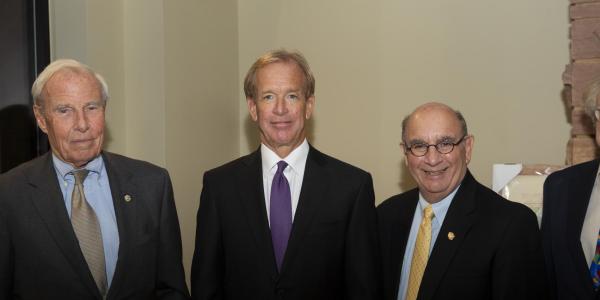‘What we want to do is to help build people who will actually have big job offers before they even leave CU,’ donor says
While the film studies program at the University of Colorado ɫ������ has a long history of making and teaching edgy, experimental and contemporary films, the program also teaches narrative and documentary films. The program has 10 tenured or tenure-track faculty and two instructors who bring rich and diverse experiences into all areas of film. (Related story��.)
With the recent gift of more than $3 million worth of professional preservation and archiving equipment from Wyndham Hannaway, a visual-effects specialist, film studies will be adding film preservation and archiving to its offerings. Hannaway’s ɫ������ company,��, has been a leader in creating innovative professional imaging for film and media services for more than 35 years.
With this equipment in place, the CU-ɫ������ Film Studies Program is looking at adding a certificate and perhaps a professional master’s degree in preservation, restoration and archiving.
Meet “Thumper,” the 16mm and 35mm Film scanner used on “Babe Pig in the City” and other productions. The scanner is a modified Oxberry Optical Printer consisting of a Projector Movement and A liquid Cooled 4K Camera Head. Each Film frame is scanned 4 times at a 4K resolution in Red, Green, and Blue, as well as Alpha Channel for dust removal. This design is crucial for film preservation and color separation elements for storage. Photo by Andrew Busti.
Film studies is now poised at the forefront of this promising area of growth, making CU-ɫ������ one of very few universities in the country with a preservation and archiving program, according to Professor Ernesto Acevedo-Muñoz, director of film studies.
Paradoxically, transferring from digital to 35 mm film for preservation purposes is the wave of the future, because digital formats can degrade at an astonishing speed or simply become corrupted, Acevedo-Muñoz says, noting that this reflects the need to back up data files.
“So, in order to ‘preserve’ any visual image originated in any digital format, the only way to ensure that is to make aphotographic��negative on film, from which copies can be made (even if it’s to reconvert them to digital),” he adds.
Hannaway, who is renowned for his expertise, concurred.��“One of the huge failings of our wonderful digital world is that we’re currently depending on long-term storage of most data on either magnetic media or flash drives.” he said. “Magnetic is fragile and flash is very expensive.” He also adds that digital media’s deterioration, specifically on magnetic tape, is “shocking.” Digital tape media can be copied onto new tape media every five to 10��years, but this is expensive and does not eliminate the possibility of data corruption.
“And so the problem remains for all of us—whether it’s credit cards or IBM or the government itself—how do you store stuff economically and reliably?”
Preserving data or images on film is an “incredibly durable, multi-hundred year medium,” Hannaway said.
As proof, Hannaway cites a woolly mammoth.��“A wooly mammoth was found Siberia and some parts were made of collagen, similar to what some film is made of. His collagen was just fine 10,000 years later.”
“Film” can record analog images and also digital data. “If you take modern media and convert it to digits and place the digits on film, you’ve kind of got the best of both worlds. It’s digital, but it’s on a medium that doesn’t require remastering every five or 10��years,” Hannaway said.
“Even hundreds of years from now, whatever they use as cameras could still recover imagery from either film that held pictures or film that held bits,” he said, adding,��“That’s one of the huge potentials of what I’ve donated.”
Hannaway said he would like to work with the university to create an endowed chair devoted to digital curation. One intention is to “use me while I’m available to begin to train others to understand all these old video formats, to enjoy the benefits of the multiple machines I have in every format, and to get a grasp of the maintenance and repair of the machines.”
“What we want to do is to help build people who will actually have big job offers before they even leave CU. If someone can claim that they’ve been trained in my work, then the Getty (Museum), the Library of Congress and other archival organizations would be ecstatic to have somebody that’s on that threshold between film, ��television, and digital media, their archive and their formats and the future digital systems.”
“I’ve got the deep experience… ��but now we need to train some people like me.”
“Unlike the 97 other people out of 100 who want to be movie directors and writers and producers, the three who choose to work in media archives will be employed before they leave CU, and the others will be waiting tables on Pearl Street.”
For those who are interested in archiving and curation, “there are great opportunities and you can get large salaries for working in what I call ‘digital curation.’ I want CU to be a leader by having what may be the first department in the country to train more people in that work.”
“On the surface, it doesn’t sound very creative, but when somebody brings you (media from) the Hindenburg or the moon landing, it suddenly becomes a little more relevant.”
Acevedo-Muñoz concurred: “Restoration and preservation are essential to all visual media, but in particular to film. More than 90 percent of the film material that existed before 1928 has disappeared. Preserving our film heritage is preserving American history.”
Kenna Bruner is an editor at the��. Clint Talbott contributed to this report.
��



